The passions that drive Libya's post-revolutionary transition are apparent everywhere in the capital Tripoli, not least in its vibrant graffiti. And there are other tell-tale signs – the skeletons of destroyed vehicles on Tripoli's Mediterranean beaches – of the revolution against four-decade dictator Moammar Gadhafi and the transition that may take generations to gel. Powerful messages convey the issues Libyans are grappling with, their pride in their achievements, their anger at the ousted regime, and their worries about the future.

USIP Program Officer Joyce A. Kasee has traveled to Libya since March 2013 to support nascent civil society organizations trying to advance the country's political, economic and civic progress. She works with partners on the ground on issues related to developing the country's institutional capacity to meet the needs and aspirations of the Libyan people. Additionally, she serves as USIP's Middle East and North Africa liaison for institutional partnerships in the region and in Washington. These photos are from her travels.
Warriors Affairs Commission
Billboard ads for Libya's Warriors Affairs Commission are ubiquitous in Tripoli. The commission was established to help former militia reintegrate into society after the war, shows the aspirational progression for ex-fighters: from right to left, militia member to graduate to worker and professional. The board conducts extensive research to determine the status of former fighters and their families and their needs. But delivering on the implied promise of reintegration is hampered because the commission is separate from – and dependent on – the ministries charged with delivering services such as health care, education and job training.
Everywhere the Flag
This is a typical street in Tripoli and many buildings are decked in the national flag. There's a real revolutionary spirit among many Libyans, a pride in having overthrown Gadhafi. The festive colors of the flag are featured on purses, earrings, necklaces, key chains.
Martyrs' Square
Known during Gadhafi's time as Green Square and during Italian colonial rule as Piazza Italia, Martyrs' Square isn't always this peaceful. It was the site of intense protests that ultimately led to the revolution that toppled the leader. The old souk (also known as the Old City) is off to the right. The square also becomes the site of the annual celebrations to mark the anniversary of the 2011 revolution, and when civil society organizations get frustrated now, they once again gather here to protest.
In the Spirit of Ramadan
On the wall of the old souk (also known as the Old City) behind the umbrellas of a café, a mural cites the Office of Culture and Civil Society of Tripoli with the message, "In the spirit of Ramadan, we wish our great nation the best and we hope that Allah will bless us all and complete our happiness through the achievements of the General National Congress's election."
Here We Make the Freedom
The face of this Libyan fighter, known as A'umran and credited with killing Gadhafi before later being killed himself in the fighting, is spray-painted everywhere in Tripoli.
First Free Elections in 60 Years
On July 7, 2012, Libya held its first free elections in 60 years to elect a national assembly. These images of ballot boxes, painted on a blast wall along the road between Tripoli's airport and the city center, reflect the national pride in the revolution. Artists and activists from throughout the city painted such "T-walls" everywhere in a kind of therapeutic exercise to express what the revolution meant to them. The tents allude to the practice of closing a road and lining it with such structures for a ceremonial funeral.
Blind Rage
The visceral scream from this blindfolded figure may serve to illustrate the frustration of Libyans at the difficulty of the transition and the frequent setbacks. It's hard to know the artist's intent, but some Libyans see it as a depiction of someone who's lost all ability to see clearly and all he has is rage.
Early Resistance Hero
This mysterious, sweeping image is on a blast wall on the road between the Tripoli airport and the city center. The figure shown is Omar Almukhtar, a Libyan hero who led the resistance against Italian colonization in the early 1900s. He's also featured on the country's 10 dinar note.
Chasing Him Down
An artist paints on a wall in Tripoli the narrative of the revolution – Gadhafi trying to sneak away with Libya's oil wealth, and revolutionaries chasing him down.
Dripping in Blood
Libyan rebels are referred to as martyrs, and their names are painted everywhere on walls, even cars, here dripping in blood. Tradition considers it a serious duty of a fighter's family to make sure his sacrifice is honored.
To the Martyrs
A lavishly painted banner of one of the many "martyrs" to the Libyan revolution, soldiers who fought Gadhafi.
Day of Rage
An artist's celebration of Libyans freeing themselves from the prison and chains of Gadhafi's oppression. The lettering around the sun is the date Feb. 17, the anniversary of the "Day of Rage" uprising that started it all. There's also an allusion to the destruction of the process itself and how much further they have to go.
Knockout
Gadhafi getting it from all sides, and the final knockout blow. Gadhafi was killed in October 2011 during fighting in the area of his hometown Sirte.
Rebels in Arms
A painted silhouette of Libyan revolutionaries raising their arms in triumph.
Hair on Fire
Libyans are fascinated by the American children's cartoon character Sponge Bob Square Pants, though they see his character as ridiculous, similarly to the way they view Gadhafi, whose hair is on fire in this mural on the wall of a school compound.
The Detritus of War
These burned out vehicles are everywhere, including on this stretch of coast in Tripoli. The revolutionaries would park them back to back and set them on fire as barricades against Gadhafi's forces.